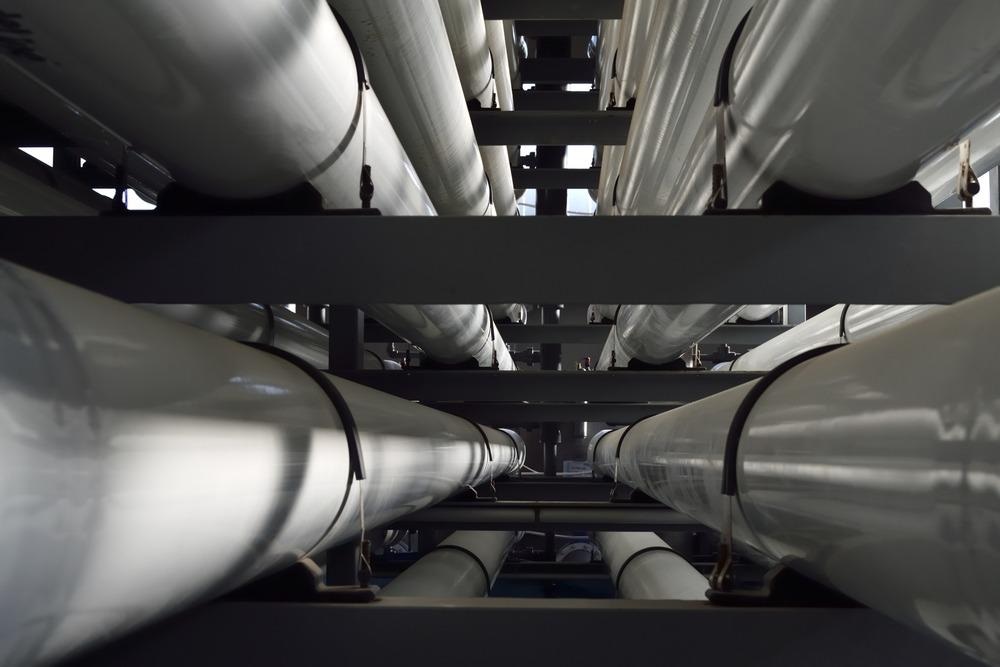 By Surbhi JainReviewed by Susha Cheriyedath, M.Sc.Apr 22 2022
By Surbhi JainReviewed by Susha Cheriyedath, M.Sc.Apr 22 2022In an article recently published in the journal Desalination, researchers discussed the development of a graphene-based woven filter membrane with exceptional strength and efficiency for water desalination.

Study: Graphene-based woven filter membrane with excellent strength and efficiency for water desalination. Image Credit: Jose Manuel Macias/Shutterstock.com
Background
With the rising demand for freshwater, saltwater desalination has emerged as a significant method of obtaining it in recent years. Reverse osmosis (RO) is currently the most widely used method and has the lowest cost. The filter membrane at the heart of the RO process, on the other hand, is still made of thin-film composite (TFC) membranes from 40 years ago. As a result, the preparation of filtration membranes with improved selectivity and permeability is the long-term goal in this research area to improve seawater desalination efficiency.
Membrane scaling, fouling, and deterioration are the most common serious limitations of these membranes. The preparation of thin-film nanocomposite (TFNC) membranes incorporating nanoparticles presents a significant possibility in the desalination sector in terms of experiments.
Since nanoporous graphene (NPGs) have substantially higher permeability than currently available RO membrane materials, there has been a lot of interest in utilizing graphene and graphene oxide to produce filter membranes. The porosity of NPGs, on the other hand, reduces the mechanical qualities and desalination efficiency significantly. Researchers have recently used simulation calculations to duplicate the weaving method to weave graphene and carbon nanotubes into new materials, which are considered good candidate materials in the aerospace area due to their great strength, toughness, and mobility.
About the Study
In this study, the authors discussed the weaving of graphene strips into filter membranes (GWFMs), which could dramatically improve mechanical properties. Molecular dynamics (MD) simulation was used to calculate flow rate, water flux, mechanical properties, and salt rejection of GWFMs. GWFMs were used in two nanopore sizes: 0.8 nm and 0.6 nm.
The team used MD simulation to assess the desalination potential of graphene-based woven filter membranes. The GWFMs' appropriate nanopore size was first screened, and then their water flux, water flow parameters, mechanical properties, and desalination performance were thoroughly examined.
The researchers used the woven density to control the size of the nanopore in GWFMs. The mechanical properties and water flux of GWFMs under different pressures were computed and examined extensively using MD simulation, and the free energy barriers of Cl-, Na+, and H2O passing through GWFMs were also evaluated to analyze the performance of salt rejection of GWFMs.
Observations
GWFM-0.8 nm and GWFM-0.6 nm had ultimate stresses of 42.29 GPa and 47.87 GPa, respectively, with ultimate strains of 27.07% and 28.46%. With a fracture strength of roughly 66.9 MPa, GWFMs had nearly 1000 times the tensile strength of current reverse osmosis (RO) membranes. Furthermore, NPGs with porosities of 79.9% and 23.6% had tensile strengths of 34 GPa and 8 GPa, respectively.
More from AZoM: Avoiding High-Temperature Material Corrosion in Fusion Reactors
Even at a high pressure of 500 MPa, the GWFM-0.6nm could maintain nearly 100% salt rejection efficiency. GWFM-0.8nm and GWFM0.6nm had water fluxes of 39.22 ± 2.50 L cm-2 day-1 MPa-1 and 18.53 ± 0.99 L cm-2 day-1 MPa-1, respectively. During the simulation time, the salt rejection effectiveness of GWFM-0.8nm and GWFM-0.6nm under 500 MPa was 86.67% and 100%, respectively.
GWFM-0.6nm could endure maximum stress of roughly 48.87 GPa. Water molecules could readily flow through the nanopores of GWFM-0.6nm since the difference between their free energy barrier and Na+/Cl-, when they were passed through the nanopores of GWFM-0.6nm could exceed 35 kBT, but salt ions could not pass through the GWFM0.6nm under the precision of MD simulation. The difference in the free energy barrier between water molecules and Na+/Cl- could reach 35 kBT in the case of GWFM-0.6nm, which ensured nearly 100% desalination efficiency at constant pressure from 10 MPa to 500 MPa during the simulation period, according to the free energy profiles of H2O and ions which traveled through GWFMs.
GWFM-0.6nm and GWFM-0.8nm had tensile strengths of 48.87 GPa and 42.29 GPa, and water fluxes of 18.53 ± 0.99 L cm-2 day-1 MPa-1 and 39.22 ± 2.50 L cm-2 day-1 MPa-1, respectively, which were three orders of magnitude higher than existing commercial RO membranes.
Conclusions
In conclusion, this study elucidated the weaving of graphene strips into filler membranes. It was demonstrated that GWFMs have outstanding filtering performance and mechanical qualities.
The authors emphasized that this work will not only pave the way for future research in the design of better membranes for the desalination of seawater using the nano-woven technique, but it will also lay the groundwork for future research in the design of suitable membranes for the desalination of seawater using the nano-woven technique.
They also mentioned that the findings of this study give a broad foundation for leveraging nano-woven technology to build desalination membranes with high water flux and tensile strength.
Disclaimer: The views expressed here are those of the author expressed in their private capacity and do not necessarily represent the views of AZoM.com Limited T/A AZoNetwork the owner and operator of this website. This disclaimer forms part of the Terms and conditions of use of this website.
Source:
Liu, T., Lyv, J., Xu, Y., et al. Graphene-based woven filter membrane with excellent strength and efficiency for water desalination. Desalination 533 115775 (2022). https://www.sciencedirect.com/science/article/abs/pii/S0011916422002302